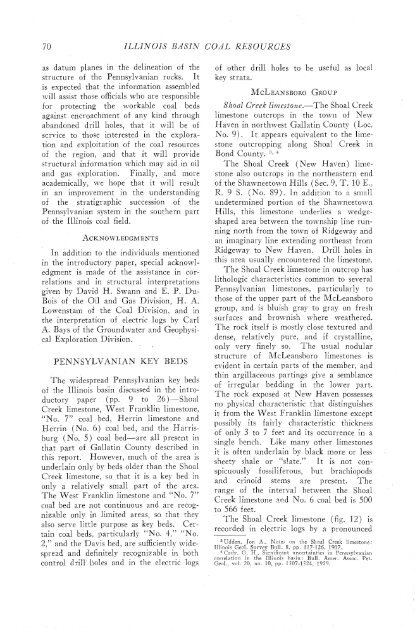subsurface geology and coal resources of the pennsylvanian system ...
subsurface geology and coal resources of the pennsylvanian system ...
subsurface geology and coal resources of the pennsylvanian system ...
Create successful ePaper yourself
Turn your PDF publications into a flip-book with our unique Google optimized e-Paper software.
70 ILLINOIS BASIN COAL RESOURCES<br />
as datum planes in <strong>the</strong> delineation <strong>of</strong> <strong>the</strong> <strong>of</strong> o<strong>the</strong>r drill holes to be useful as local<br />
structure <strong>of</strong> <strong>the</strong> Pennsylvanian rocks. It kev strata.<br />
is expected that <strong>the</strong> information assembled<br />
MCLEANSBORO GROUP<br />
will assist those <strong>of</strong>ficials who are responsible<br />
for protecting <strong>the</strong> workable <strong>coal</strong> beds<br />
against encroachment <strong>of</strong> any kind through<br />
ab<strong>and</strong>oned drill holes, that it will be <strong>of</strong><br />
service to those interested in <strong>the</strong> exploration<br />
<strong>and</strong> exploitation <strong>of</strong> <strong>the</strong> <strong>coal</strong> <strong>resources</strong><br />
<strong>of</strong> <strong>the</strong> region, <strong>and</strong> that it will provide<br />
structural infoi-mation which may aid in oil<br />
<strong>and</strong> gas exploration. Finally, <strong>and</strong> more<br />
academically, we hope that it will result<br />
in an improvement in <strong>the</strong> understamding<br />
<strong>of</strong> <strong>the</strong> stratigraphic succession <strong>of</strong> <strong>the</strong><br />
Pennsylvanian <strong>system</strong> in <strong>the</strong> sou<strong>the</strong>rn part<br />
<strong>of</strong> <strong>the</strong> Illinois <strong>coal</strong> field.<br />
In addition to <strong>the</strong> individuals mentioned<br />
in <strong>the</strong> introductory paper, special acknosvledgment<br />
is made <strong>of</strong> <strong>the</strong> assistance in correlations<br />
<strong>and</strong> in structural interpretations<br />
given by David H. Swann <strong>and</strong> E. P. Drr-<br />
Bois <strong>of</strong> <strong>the</strong> Oil <strong>and</strong> Gas Division, H. A.<br />
Lowenstam <strong>of</strong> <strong>the</strong> Coal Division, <strong>and</strong> in<br />
<strong>the</strong> interpretation <strong>of</strong> electric logs by Carl<br />
A. Bays <strong>of</strong> <strong>the</strong> Groundwater <strong>and</strong> Geophysical<br />
Exploration Division.<br />
PENNSYLVANIAN KEY BEDS<br />
The widespread Pennsylvanian key beds<br />
<strong>of</strong> <strong>the</strong> Illinois basin discussed in <strong>the</strong> introductory<br />
paper (pp. 9 to 26)-Shoal<br />
Creek limestone, West Franklin limestone,<br />
"No. 7" <strong>coal</strong> bed, Herrin limestone <strong>and</strong><br />
Herrin (No. 6) <strong>coal</strong> bed, <strong>and</strong> <strong>the</strong> Harrisburg<br />
(No. 5) <strong>coal</strong> bed-are all present in<br />
that part <strong>of</strong> Gallatin County described in<br />
this report. However, much <strong>of</strong> <strong>the</strong> area is<br />
underlain only by beds older than <strong>the</strong> Shoal<br />
Creek limestone, so that it is a key bed in<br />
only a relatively small part <strong>of</strong> <strong>the</strong> area.<br />
The West Franklin limestone <strong>and</strong> "No. 7"<br />
<strong>coal</strong> bed are not continuous <strong>and</strong> are recognizable<br />
only in limited areas, so that <strong>the</strong>y<br />
also serve little purpose as key beds. Certain<br />
<strong>coal</strong> beds, particularly "No. 4," "No.<br />
2," <strong>and</strong> <strong>the</strong> Davis bed, are sufficiently videspread<br />
<strong>and</strong> definitely recognizable in both<br />
control drill holes <strong>and</strong> in <strong>the</strong> electric logs<br />
Shoal Creek li7i~estone.-The Shoal Creek<br />
limestone outcrops in <strong>the</strong> town <strong>of</strong> New<br />
Haven in northwest Gallatin County (Loc.<br />
No. 9). It appears equivalent to <strong>the</strong> limestone<br />
outcropping along Shoal Creek in<br />
Bond County. " '<br />
The Shoal Creek (New Haven) limestone<br />
also outcrops in <strong>the</strong> nor<strong>the</strong>astern end<br />
<strong>of</strong> <strong>the</strong> Shawneetown Hills (Sec. 9, T. 10 E.,<br />
R. 9 S. (No. 89). In addition to a small<br />
undetermined portion <strong>of</strong> <strong>the</strong> Shawneetown<br />
Hills, this limestone underlies a n-edgeshaped<br />
area between <strong>the</strong> township line running<br />
north from <strong>the</strong> town <strong>of</strong> Ridgeway <strong>and</strong><br />
an imaginary line extending nor<strong>the</strong>ast from<br />
Ridgeway to New Haven. Drill holes in<br />
this area usually encountered <strong>the</strong> limestone.<br />
The Shoal Creek limestone in outcrop has<br />
lithologic characteristics common to several<br />
Pennsylvanian limestones, particularly to<br />
those <strong>of</strong> <strong>the</strong> upper part <strong>of</strong> <strong>the</strong> Pc4cLeansboro<br />
group, <strong>and</strong> is bluish gray to gray on fresh<br />
surfaces <strong>and</strong> brownish where wea<strong>the</strong>red.<br />
The rock itself is mostly close textured <strong>and</strong><br />
dense, relatively pure, <strong>and</strong> if crystalline,<br />
only very finely so, The usual nodular<br />
structure <strong>of</strong> McLeansboro limestones is<br />
evident in certain parts <strong>of</strong> <strong>the</strong> member, <strong>and</strong><br />
thin argillaceous partings give a semblance<br />
<strong>of</strong> irregular bedding in <strong>the</strong> lower part.<br />
The rock exposed at New Haven possesses<br />
no physical cha.racteristic that distinguishes<br />
it from <strong>the</strong> West Franklin limestone except<br />
possibly its fairly characteristic thickness<br />
<strong>of</strong> only 3 to 7 feet <strong>and</strong> its occurrence in a<br />
single bench. Like many o<strong>the</strong>r limestones<br />
it is <strong>of</strong>ten underlain by black more or less<br />
sheety shale or "slate." It is not conspicuously<br />
fossiliferous, but brachiopods<br />
<strong>and</strong> crinoid stems are present. The<br />
range <strong>of</strong> <strong>the</strong> interval between <strong>the</strong> Shoal<br />
Creek limestone avd No. 6 <strong>coal</strong> bed is 500<br />
to 566 feet.<br />
The Shoal Creek limestone (fig. 12) is<br />
recorded in electric logs by a pronounced<br />
Uclden, Jon A,, Notes on <strong>the</strong> Shoal Creek limestone:<br />
Illinois Geol. Survey Bull. 8, pp. 117-126, 1907.<br />
" Cady. G. I-I., Sienificant u!lcertainties in Pennsylvanian<br />
col-relation in <strong>the</strong> Illinois has~n: Bull. Amer. Assoc. Pet.<br />
GeoI., vol. 20. no. 10. pp. 1507-1524, 1929.
















